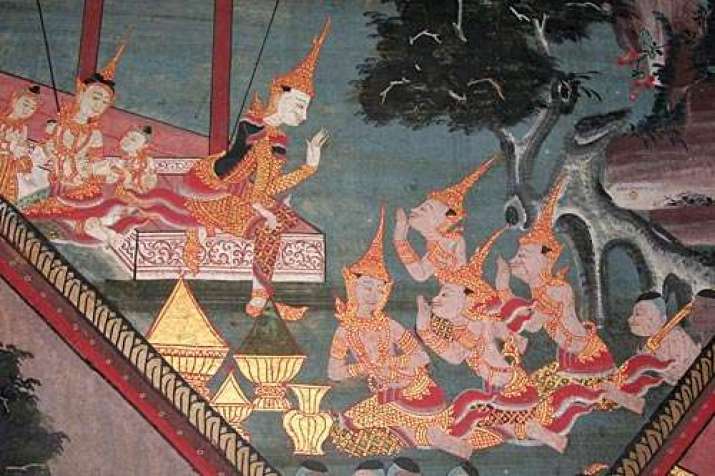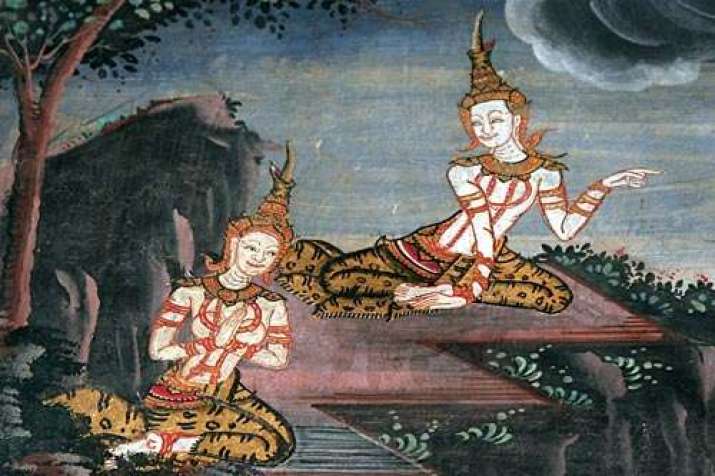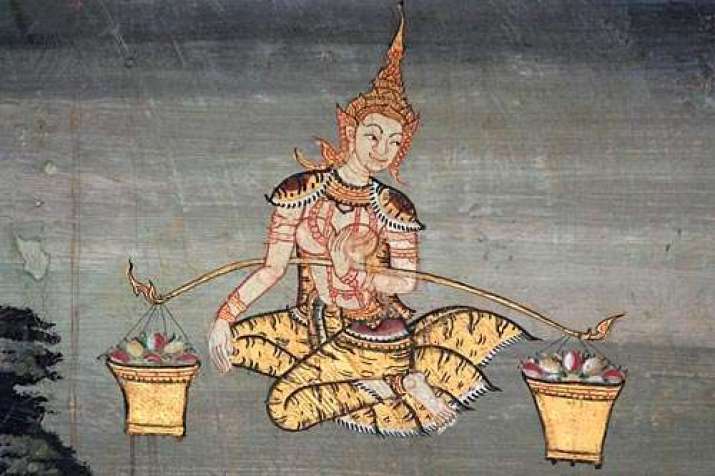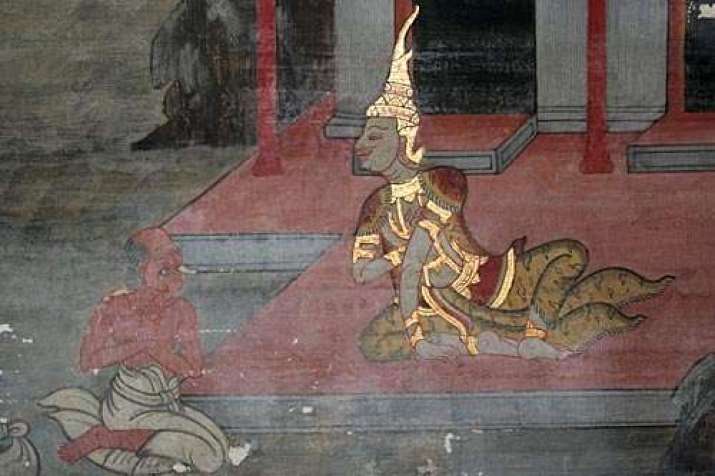FEATURES|THEMES|Commentary
A Wrestling Match with Vessantara
 Vessantara, Maddi, and their children with attendants at the palace. From buddha-images.com
Vessantara, Maddi, and their children with attendants at the palace. From buddha-images.comContemporary Buddhists will often declare that you can be a Buddhist and still be of the world. You can even practice at the kitchen sink. You can meditate while raising your kids, manifest compassion as you fulfill your job requirements, attend to the details of a busy life and still profess a sincere Buddhist practice. Road rage might be a stretch of the imagination, but the rest can probably fit this category if your intentions are right.
But then . . . there is the Vessantara Jataka, and everything I understand about life comes to a halt. I am sure you know the story—it is the most popular past-life narrative in the Buddhist scriptural pantheon—but just in case, here is a basic outline: a long time ago, in a land far, far away, just before the Buddha became the Buddha, he was reborn as Prince Vessantara. He came out of the womb wanting to practice generosity, telling his mother, “Quick, give me something to give,” as he extended his little newborn hand. When he got older, the desire to practice generosity grew stronger. When he began to take on royal responsibility, the prince became impossible. Anything anyone asked, he gave. Eventually the king realized that his son might give his entire kingdom away, so he exiled him to the forest, where—he assumed—his son would no longer have anything more to give.
Vessantara leaves for the forest, but he does not leave alone; his wife Maddi insists on going with him and brings the children with her. Together, they make a life for themselves in a hut of leaves, scavenging for nuts and fruits. They become renunciants together, and that could have been the end of the story, but as most of you surely know, the story is far from over.
An evil Brahmin named Jujaka spots the vulnerable family and makes an audacious request: “Please, sir,” he slithers. “My wife is too lazy to work; we need slaves. Will you give us your children as gifts?” Since Vessantara made a vow to give what was asked of him, he (apparently) had no choice but to say yes.
 Vessantara and his wife Maddi live as hermits in the forest. From buddha-images.com
Vessantara and his wife Maddi live as hermits in the forest. From buddha-images.comThings get worse from here. After Jujaka rips the children away from their father (they cling to his legs in desperation) and drags them into the dark forest, Vessantara is tested one more time: he is asked to gift his wife. Obviously, Vessantara says yes. Because that is what Vessantara does.
There are so many elements to this story that one really never knows what to tackle first. The family is later magically reunited in a happily-ever-after ending, probably because it is otherwise impossible to digest, but the ending does not eliminate the tale’s complexity. It is one of the most difficult stories in Buddhist literature, and yet it is beloved all over the world.
I have thought about this story a lot over the years. Sometimes I can find my way to inspiration, but most of the time I am conflicted. What kind of a story is this? What does it mean?
The most obvious answer is that this story is about generosity and renunciation: to achieve something immeasurable like buddhahood, we must be prepared to give everything else up. Nothing should compare to achieving awakening—not even one’s own family members. One’s own children. But then, if that is true, most of us are doomed to fail. Who among us is really prepared to give up our children to slave-masters?
The answer to that is usually quick too: almost no one. Which is why buddhahood is so precious—because so few are capable of reaching it.
 Maddi, Vessantara's wife, collects food in the forest. From buddha-images.com
Maddi, Vessantara's wife, collects food in the forest. From buddha-images.comBut . . . what kind of a tradition are we wrestling with, in that case? A tradition that dismisses children, sends them to slave masters in exchange for Awakening? If Vessantara gave his children to a loving family member, we might be able to forgive him. But he gives them to Jujaka, an evil slave master whose wife is too lazy to carry water herself. How is this the Buddhist narrative?!
A counter-argument immediately rises to the surface at this point: Vessantara wasn’t the Buddha. This is a past-life story, before he had attained awakening. An awakened being would never do that. Buddhism is not so cruel.
But . . . there is another question to follow, begging to be asked: Vessantara was only one step away from Buddhahood. The Buddhist cosmos imagines life stories stretching back hundreds of thousands of lifetimes into the past. When the Bodhisatta took rebirth as Vessantara, he was nearly perfect. He would achieve buddhahood in the very next life. How can a nearly perfect being practice generosity and renunciation so blindly?
Now comes the counter-move: like god-based religions which claim that some things are beyond our comprehension (which often feels like a cop-out), Buddhism follows suit. The behavior of one so close to buddhahood is simply beyond our comprehension. Vessantara was operating on a different level, wrestling with ideas that we simply cannot relate to. He gave up everything because he was ready to give up everything. Most of us can’t even give up chocolate. Are we really expected to relate?
 Jujaka, the old man, asks Vessantara for his children to be his slaves. From buddha-images.com
Jujaka, the old man, asks Vessantara for his children to be his slaves. From buddha-images.comArguments, counter-arguments, and more counter-arguments. Buddhism has an answer for everything and sometimes that can be infuriating. I take a deep breath and aim for inspiration, trying to convince myself that I am too simple to relate to such depth. But then I remember the popular rhetoric of contemporary Buddhism and I get flustered all over again: apparently, I am supposed to be able to practice Buddhism while doing the dishes! That sounds like a far cry from the extremes of the Vessantara Jataka. According to one worldview, I would have to give everything up without exception—including my family—while the other says that I don’t need to give up anything at all. Simply adjust my mind instead.
I realize, of course, that Buddhism is not a monolith. There are a million answers for every question. A million trajectories all in Buddhism’s name, and far be it from me to declare which one is right. But the Vessantara Jataka seems to float in a different stratosphere at times. How much am I supposed to give up? What does it mean to be a Buddhist? Sometimes, I really don’t think practicing at the kitchen sink is enough.
I have so many questions. I have been studying this tradition for more than 25 years, and I am no closer to answering any of them now than I was then.
Related features from Buddhistdoor Global
Moonbeams of Mahāmudrā: Perspectives on a New Translation by Elizabeth Callahan
Practicing Gratitude When the Sh*t Hits the Fan: Plutarch and the Practice of Blending
Inner Immensity at the Great Assembly














